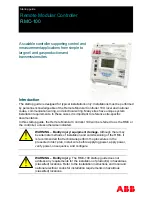
2105551-001 rev. AC |
9
7. Insert the communication module in the appropriate slot (Figure 2). The
communication module pushes the port cover downward when inserted.
COMM 1
COMM 2
RMCIO
EXPANSION
COMM 2
COMM 1
BAT CHARGER/EXT PWR PI
1 2 3 4 5 6
7 8 9
1 2 3 4 5 6
7 8 9
Figure 2: COMM terminals and modules
4.4 Wiring I/O ports
Wire the RMC I/O ports to monitor, control and power external devices. Wiring for
power is required if there is no external supply powering the device.
To wire the I/O port:
IMPORTANT NOTE:
Refer to the RMC user drawings for I/O wiring
details for specific external devices. See the
Additional information
section.
CAUTION – Equipment damage.
An external device can be powered
from pin 1 (PWR) on any of the AIs (Table 3) or the AO (Table 4). The
output voltage at the PWR pin is dependent upon the external power
supply connected to the CHARGER/EXT PWR port.
Before connecting to these pins, ensure that the external device is
compatible with the input voltage at the CHARGER/EXT PWR port.
Connecting an incompatible device may result in damage to the device.
1. Use a slotted screwdriver to pry the terminal connector off the electronic board.
2. Trim the wire covering back ¼ inch on each wire.
3. Loosen the terminal connector screws for the correct pin according to the I/O
tables. See sub-sections 4.4.1, 4.4.2, 4.4.3, and 4.4.4 in this guide.
4. Insert the wires in the required pins. If powering the device from the AI or the
AO:
a. Use pin 1 (PWR) and pin 3 (GND) for devices attached to the AI.
b. Use pin 1 (PWR) and pin 4 (GND) for devices attached to the AO.
5. Tighten the terminal connector screws.
NOTICE – Property damage.
Do not overtighten the terminal
connector screws as this may damage the wire.
6. Insert the terminal connector back on the I/O port if it was removed.
























